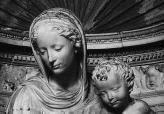
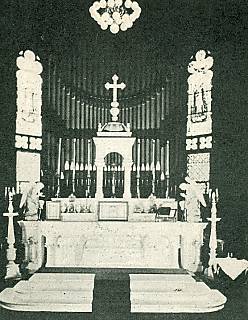
The Altar
Crosses are placed in the center and on the four corners of the mensa to recall the five wounds of Christ’s body. Since the altar is the place of sacrifice, where, after the consecration of the Holy Mass the particle consecrated becomes the body and blood of our Lord, Jesus Christ, the altar must be dedicated at a special ceremony by the Bishop of the Diocese. The altar prepared for Holy Mass is covered with three white linen cloths which are provided to absorb the consecrated species of the wine or the precious blood should it be accidentally spilled.
To the right on the altar table is the Mass book called “The Missal.” This book contains not only the common prayers said daily but the seasonal and feast day prayers for the entire year. The three altar cards contain some of the common prayers recited by the priest daily at the Holy Mass. The candles for a Low Mass are two in number. For a High Mass six candles are lighted.
These candles are made of beeswax. The vault-like portion in the center of the altar is called the tabernacle or the depository for the Blessed Sacrament. It is richly ornamented. The inside usually is beautifully draped to afford a suitable throne for the King of kings. Above the tabernacle is found a crucifix which recalls to our minds the Sacrifice of Calvary.
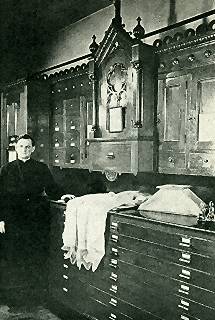
The Priest in the Sacristy
The Chalice and Paten are made of gold because only the most rare and costly utensils should be used at the Holy Sacrifice. They must be consecrated by the Bishop and ordinarily can only be touched by the priest. The Mass is a repetition of the Last Supper, and the Chalice and the Paten are representative of the cup and the dish used by our Lord at the Last Supper.
The Paten is the repository for the Host at Offertory and the Chalice contains the wine. The Purificator is an oblong piece of white linen used to purify the Chalice. You will observe in your study of the Offertory that the celebrant performs this action of purification.
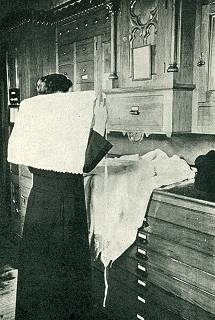
The Priest Puts On the Amice
“Give virtue, O Lord unto my hands that every stain may be wiped away, that I may be enabled to serve Thee without defilement of mind or body.”
Then the priest puts on the Amice. The Amice is a small rectangular linen cloth with two strings attached to fasten it. The word has it derivation from the Latin and means, “to wrap around.” It is used as a protection for the vestments and before being placed on his shoulders the celebrant touches his head and forms a helmet as a protection against Satan. As he puts on the Amice, he says,
“Place, O Lord, the helmet of salvation upon my head that I may overcome the assaults of the devil.”
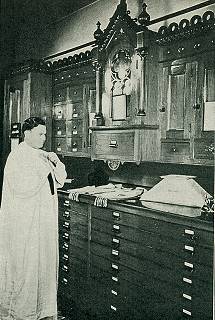
The Priest Puts On the Alb
“Cleanse me, O Lord, and purify my heart that being made white in the blood of the Lamb I may have the fruition of everlasting joy.”
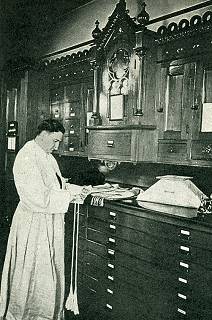
The Priest Puts On the Cincture
“Gird me, O Lord, with the girdle of purity and extinguish in my loins the desires of lust so that the virtue of continence and chastity may ever abide within me.”
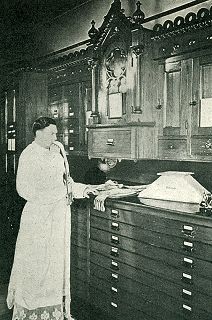
The Priest Puts On the Maniple
“May I be worthy, O Lord, so to bear the Maniple of tears and sorrow: that with joy I may receive the reward of my labor.”
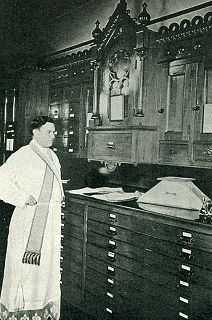
The Priest Puts On the Stole
The name is derived from the Latin “stola” which was the distinctive garment of the nobility. The priest first kisses the cross in the center of the Stole and places it on his shoulders saying,
“Restore to me, O Lord, the Stole of immortality which I lost by the transgression of the first parent: and although unworthy, as I draw near to Thy sacred mystery, may I be found worthy of everlasting joy.”
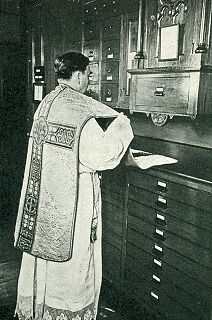
The Priest Puts On the Chasuble
The violet vestment indicates a sign of penance, the white of joy, red of love, green of hope, and black of sorrow. This vestment is also significant of charity and as the priest places this garment over his head he says,
“O Lord, Who hast said: ‘My yoke is easy and My burden is light’ make me able to bear it, that I may obtain Thy favor. Amen.”
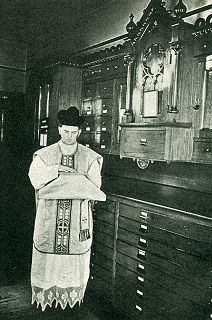
The Priest Is Prepared for Holy Mass
“Father, not My will but Thine be done.”
Raise your hearts in pity for your Savior, Who suffered so for you. Be sorry for your sins and pray with the priest raising your hearts to God.
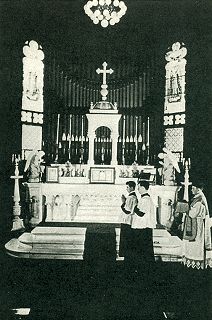
The Celebrant Enters the Sanctuary
You will say the following prayer (interiorly):
“O Jesus, because Thou art merciful, I hope in Thee; I hope to obtain pardon of my sins, grace to serve Thee in this life and nevermore to offend Thee! O dear Jesus, I firmly believe that Thou art really and truly present in the most Holy Sacrament of the Altar. I believe that here is Thy most sacred Body and Blood under the humble appearances of bread and wine.”
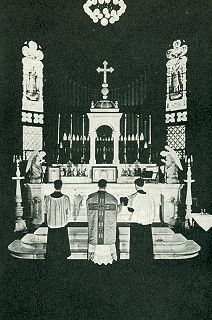
The Priest Ascends to the Altar
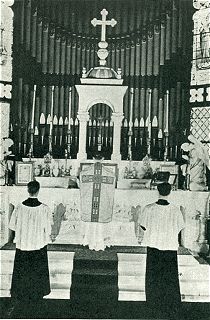
The Priest Places the Chalice
As the priest prepares the chalice, let us join quietly and silently in the following prayer:
“O my God, I love Thee above all things with my whole heart and soul, because Thou art infinitely worthy of my love. I love my neighbor as myself, for the love of Thee: I forgive all who have injured me and ask pardon of all whom I have injured.”
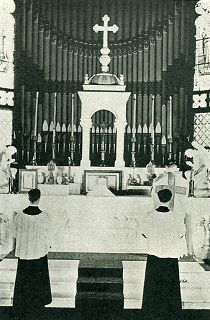
The Celebrant Prepares the Missal
“O Almighty and Eternal God, look upon the heart of Thy dearly beloved Son and upon the praise and satisfaction He offers Thee in the name of sinners and for those who seek Thy mercy.”
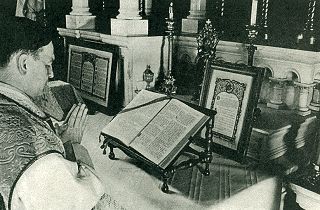
Missal Prepared
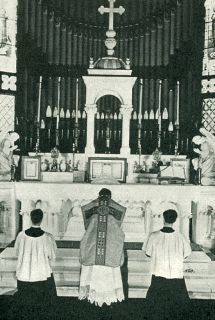
Prayers at the Foot of the Altar
“We approach Thy holy altar, O God Almighty, the Joy of our youth, our Protection, our Faith. To Thee we fly for protection against the enemy of our souls.”
You will observe that the celebrant is reverently inclined forward saying the following:
“I confess to Almighty God, to the Blessed Mary ever Virgin, to blessed Michael the Archangel, to blessed John the Baptist, to the holy Apostles Peter and Paul, to all the saints and to you brethren that I have sinned exceedingly in thought, word and deed.”
It is at this time that the priest and the people before the altar of God confess their unworthiness and indicate by the profound bow their guilt of sin, and striking their breasts say (interiorly by the faithful):
“Through my fault, through my fault, through my most grievous fault.”
The priest asks God for the forgiveness of his own sins and the sins of all present who may be guilty of sin.
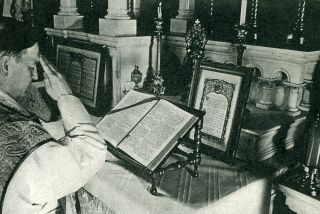
The Introit
“We beseech Thee through the unbloody sacrifice of Thy Son, Jesus Christ Who died to redeem us, give us They grace that we may devoutly assist at this holy sacrifice. And let us partake of the merits of our Savior. Amen.”
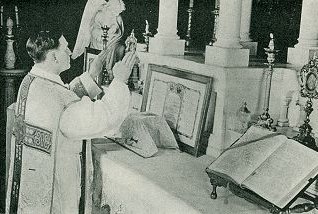
The Gloria
“Lord, have mercy on us! Christ, have mercy on us! Lord have mercy on us!”
Upon the completion of this prayer he recites the Gloria which begins with the beautiful hymn of praise which the angels chanted on Christmas night when our Lord was born in the stable at Bethlehem.
“Glory be to God in the highest and on earth peace to men of good will.”
The priest raises his arms and hands reverently towards Heaven during this prayer as a sign of joy. This prayer is omitted in Masses for the Dead.
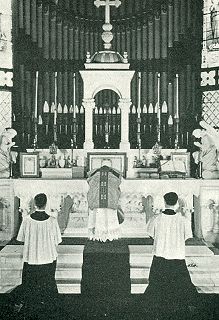
Priest Kisses the Altar
(Viewed from back of Church)
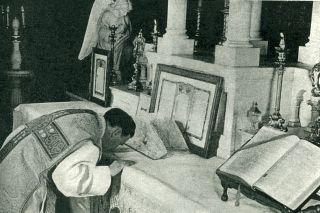
Priest Kisses the Altar
(Viewed from side of altar)
During this ceremony we may join in silent prayer saying:
“I bow down before Thee in this great sacrament of Thy love and adore Thee as my Lord and my God, my Redeemer and Savior. We adore Thy real presence in the Sacrament of They love. Confirm my faith of Jesus.”
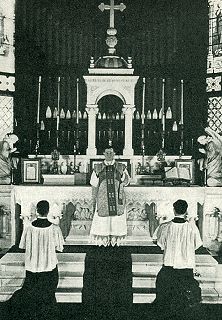
The Dominus Vobiscum
is the prayer which the celebrant says at this time. The servers who represent the Faithful reply,
“And with Thy spirit.”
In this action the priest encourages the congregation to take an active part (interiorly) with him in the Holy Sacrifice. This prayer is repeated eight times during the Mass.
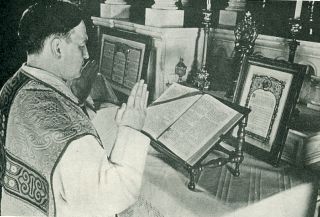
The Oration
“Let us pray. O God of mercy, refuge of those who hope in Thee, hear our prayers. We can do nothing without Thee. Give us Thy holy grace that we may keep Thy commandments, and that all actions may be pleasing to Thee. Amen.”
You will observe that during this prayer the celebrant keeps his hands apart and elevated in penance and to symbolize the unity of prayer of his congregation. This part of the Mass is called the Collects because the people have joined with the priest in asking God for the spiritual faith needed.
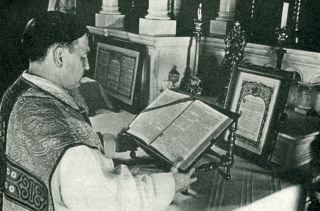
The Epistle
It will also be noticed that the priest holds the Missal as he reads the Epistle and this signifies that we should be doers of the Word and not hearers only.
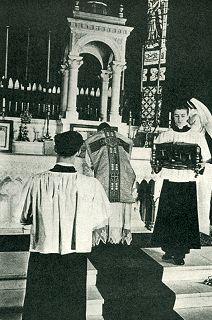
The Server Transfers the Missal to the Gospel Side
“O my God to Thee I offer up all my thoughts, words and actions. May they all be done to Thy honor.”
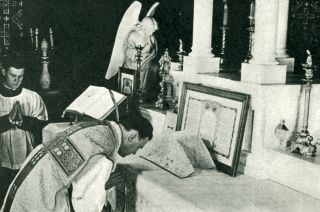
Munda Cor Meum
“I bow down before Thee in this great Sacrament of Thy love and adore Thee as my Lord and my God, my Redeemer and Savior.”
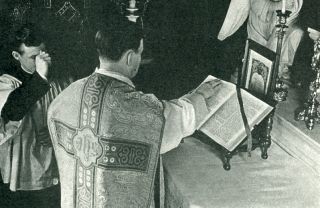
The Gospel
We must all stand to hear the word of the Gospel which is the word of Jesus Christ Himself. We must all sign ourselves as did the priest on the forehead, the lips and the breast. Upon completion of the reading of the Gospel the priest kisses the Gospel portion of the Missal. The people through the servers express their devotion to our Lord by replying.
"Prase be to Thee, O Christ!"
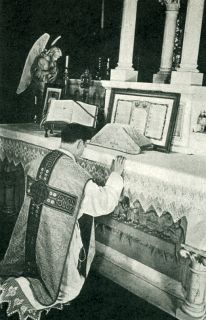
The Credo
“I believe in the Holy Ghost, the Lord and Giver of Life: Who proceeds from the Father and the Son. Who, together with the Father and Son, is adored and glorified: Who spoke through the prophets. And in One, Holy, Catholic and Apostolic Church. I confess one baptism for the remission of sins. And I expect the resurrection of the dead. And life of the world to come. Amen.”
Continue with the...
|
| Return to top of page |
|
|
| Bookmark this site |
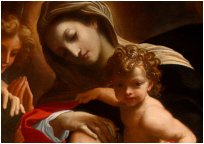
© StGemma.com Web Productions Inc. 2005-Present. All rights reserved.

Appendix I
Appendix II
Appendix III
Appendix IV
Gregory XVII "Siri"
The Coming Great Catholic Monarch
St. John Bosco's Dream (Vision) of Hell
Michael Dimond:
Original St. Michael Prayer (Exorcism)
Antichrist
Home
(Altar & Sanctuary Guide)
(Server Instructions)
(Pronunciation of Latin)
(Pius V Quo Primum)
The Pope in Red
a False Prophet
(Catholic Prophecy)
